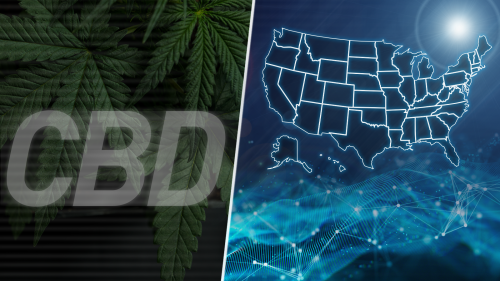Better Data for a Better Understanding of the Use and Safety Profile of Cannabidiol (CBD) Products

By: Stephen M. Hahn, M.D., Commissioner of Food and Drugs and Amy Abernethy, M.D., Ph.D., Principal Deputy Commissioner
Over a short period of time, our society has seen a rapid increase in the interest and availability of cannabidiol (CBD) products and other products derived from cannabis. However, we still have a limited understanding of the safety profile of CBD and many other cannabis-derived compounds, including potential safety risks for people and animals. At the U.S. Food and Drug Administration, we see these knowledge gaps as an opportunity to develop new ways of building the science to inform public health decisions.
The FDA evaluates CBD just like any other substance we regulate, under a regulatory framework defined by law and with rigorous scientific evidence as a basis for both our regulatory approach and information we communicate. We’ve consistently communicated concerns and questions regarding the science, safety, and quality of many of these products based on currently available evidence. We still don’t have clear answers to important questions such as what adverse reactions may be associated with CBD products and what risks are associated with the long-term use of CBD products. Better data in these areas are needed for the FDA and other public health agencies to make informed, science-based decisions that impact public health.
We see an important public health opportunity in using novel sources of data and rigorous analytical methods to build a more robust base of scientific evidence on the safety profile and use of CBD products. The FDA is uniquely situated to contribute its expertise in evaluating data from different sources to inform regulatory decision-making. We think that real-world data (RWD) on CBD use and safety has a crucial role alongside data from other types of studies to fill in the current gaps in our understanding.
What follows is a brief overview of our work on CBD and a framework for building a more robust evidentiary foundation to inform public health decisions.
Background: FDA’s Ongoing Work on CBD
In December 2018, a change in the law made the FDA’s work on CBD issues particularly important. The Agriculture Improvement Act of 2018 (also known as the 2018 Farm Bill) removed hemp from the definition of marijuana in the Controlled Substance Act (CSA). This means that cannabis plants and derivatives that contain no more than 0.3 percent delta-9-tetrahydrocannabinol (THC) on a dry weight basis are no longer controlled substances under the CSA. While hemp that meets this definition is no longer controlled under the CSA, FDA-regulated products containing hemp must still meet applicable requirements of the Federal Food, Drug, and Cosmetic (FD&C) Act.
The FDA has approved one drug, Epidiolex, that contains a highly-purified form of CBD for the treatment of seizures associated with Lennox‑Gastaut syndrome (LGS), Dravet syndrome (DS), or tuberous sclerosis complex (TSC) in people one year of age and older. During review of the marketing application for Epidiolex, the FDA identified certain safety risks, including the potential for liver injury and for adverse reactions caused by the interaction between Epidiolex and other medications. These risks are communicated in the approved labeling for Epidiolex.
Although the 2018 Farm Bill expressly did not change the FDA’s authorities regarding the regulation of CBD and other cannabis derivatives, the fact that these substances are no longer controlled substances has triggered increased interest in and availability of these ingredients for commercial development. Our website provides additional information about the agency’s activities related to CBD. The FDA’s work to develop better information on CBD and on the CBD market has been focused in the following areas: engagement with stakeholders, including on the development of data on CBD use and safety; and, sampling and testing by the FDA of CBD products in the market.
Engagement with Stakeholders on CBD Issues
When the 2018 Farm Bill was enacted, we recognized the importance of engaging with the community of stakeholders interested in CBD. We held a public hearing in May 2019 and issued a call to stakeholders to work with the agency to develop high-quality data on CBD. The FDA re-opened the May 2019 public hearing docket, and will keep it open in the future as one mechanism for stakeholders to share data. In July 2020, we gathered stakeholder and industry input regarding the challenges surrounding quality, safety, and monitoring of the current marketplace. We also held a multidisciplinary scientific conference in November 2020 to provide further insight into the scientific evidence supporting the presence or absence of sex and gender differences in use and responses to CBD and other cannabinoids. The FDA also conducts regular listening sessions with stakeholders willing to share their perspective and data with us.
As we continue to evaluate the regulatory frameworks that apply to certain cannabis-derived products that are intended for non-drug uses, including whether any new FDA regulations may be warranted, the FDA continues to work actively with drug developers through the investigational new drug, drug review, and drug approval processes. The FDA’s work in this area involves both meetings with drug developers to provide advice that is specific to the development of a proposed product, as well as the development of guidance documents on high-priority regulatory and scientific issues. For example, the FDA recently published a draft guidance “Cannabis and Cannabis-Derived Compounds: Quality Considerations for Clinical Research,” which, when final, will represent the agency’s current thinking on sources of cannabis, resources for information on quality considerations, and percent delta-9 THC calculation. The FDA is evaluating comments submitted to the agency regarding this draft guidance.
FDA’s CBD Product Sampling and Testing Activities
Sampling and testing of marketed CBD products is another way that the FDA has gathered more information about the safety profile of these products. This is an important component of the FDA’s work because little is known about the amounts of CBD and various related cannabinoids, as well as the occurrence of toxic elements, pesticides, other possible chemical contaminants, and adulterants, that may be present in CBD products that are marketed to consumers. We are testing CBD product samples in the following ways:
- The FDA at times tests products as part of its compliance and enforcement activities. For example, in connection with several warning letters sent to firms for marketing unapproved new drugs that allegedly contain CBD, the agency tested the cannabinoid content of certain products and many were found to not contain the levels of CBD they claimed to contain. The FDA made the results of such testing publicly available.
- The FDA also designed surveys of the market and currently is conducting a two-phase marketplace sampling and testing study. The first phase involved a small sampling and analysis study (~200 samples) conducted by the agency. While the data collected so far are from a limited sample size and are insufficient to draw definitive conclusions regarding the prevalence of results in marketed products, general observations indicate fewer than half of the tested products which presented label claims contained CBD at concentrations within 20% of their claimed amount and some products contained the psychoactive, intoxicating cannabinoid THC. The FDA has recently published findings from this work.
- We are currently working with a third party on conducting the second phase of the sampling plan that will involve a much larger sample set (1000-3000) that includes collection of CBD-containing products of various types.
Additional Work is Needed to Build Data on CBD Use and Safety
We are encouraged by the many groups that are interested in helping to develop better data on the use and safety of CBD products, but also note that existing efforts generally are not adequate to fill the outstanding knowledge gaps. For example, observational studies that are too small or that do not include techniques to ensure data quality or methodological rigor are of limited use for public health decision making.
While the FDA appreciates the information and engagement from numerous stakeholders on CBD-related issues, many evidence gaps remain. Filling these gaps will not be a trivial exercise but will require high-quality data analyzed using robust methods. We believe there is an opportunity to develop better sources of RWD to provide incremental improvements in our scientific understanding of the safety profile of CBD in the general population and, potentially, in specific populations.
We believe that ongoing efforts to systematically collect data on the safety and use of CBD are important and we are engaging with stakeholders to advance this work. At the same time, we see a critical opportunity for the FDA to work collaboratively with partners in government, industry, and academia to develop the foundation for more robust CBD data collection and analysis projects.
A Practical Framework for Robust, Collaborative CBD Data Projects to Inform Public Health Decisions
Here, we describe a framework for the FDA’s work in the development of research projects that lay the methodological groundwork for high quality RWD science on the safety and use of CBD products. These research projects would be aimed at building upon currently existing independent state and national quality and safety monitoring efforts, observational study data models, and novel data sources to develop more robust capabilities and methods for CBD data collection and analysis.
We know from experience that collaborative projects with researchers across government, academia, and the private sector can stimulate rapid progress in the development of rigorous methods for collecting and analyzing RWD. Most recently, in the context of COVID-19, collaborative research projects between the FDA and outside data experts have focused on using RWD to improve analytical methods and inform the public health response to the pandemic.
It is important to note that there are research questions for which RWD research projects are unlikely to substitute for certain types of traditional studies. We do not expect that analyses of observational data will substitute for other types of studies in certain contexts. For example, appropriately designed animal studies can address toxicological issues that are difficult to study in humans, such as chronic, developmental, and reproductive toxicity.
However, we strongly believe that RWD, when collected and analyzed using rigorous methods, can be important for moving the science forward—including by aiding hypothesis generation and by refining the design of follow-up studies. For example, RWD may identify new potential adverse events or subpopulations of CBD users that should be the focus of follow-up studies.
For CBD data collection and analysis efforts to have the maximum scientific impact, they should be designed to address the most significant practical and scientific challenges in this area. Below, we highlight challenges in current capabilities for collecting and evaluating CBD-related data and point to a framework for the FDA’s development of research projects that leverage novel data sources and can form the foundation for additional research on the safety profile of CBD products. First, we describe principles that we believe should guide this work.
Guiding principles for FDA’s work in this area include the following:
- Research projects should contribute, where possible, to the development of more sophisticated data infrastructure for understanding the safety and quality of CBD products.
- Research projects should yield information that helps us refine future studies—for example, by identifying potential adverse events or subpopulations that are most important to study further.
- Research projects should be designed with the goal of complementing existing work by other public health agencies, such as NIH and SAMHSA, as well as other stakeholders. States provide an important laboratory for novel data collection and analysis. The FDA projects should build on existing efforts at the state and national level to incorporate data from poison control centers, emergency departments, and other potential sources of information about adverse events related to CBD products.
Challenges in current capabilities for collecting data regarding the use and safety of CBD
- Much of the existing data on CBD use in the general population comes from spontaneously reported adverse events (e.g., from poison control centers), but more systematic data collection and analysis will be crucial for understanding relative safety risks.
- Rates of CBD use, and rates of use of specific CBD products, are poorly understood. What is the denominator of risk for adverse events in the population taking CBD? What specific populations have the highest CBD exposures and what specific products are frequently used? What other products, such as over-the-counter or prescription drugs, are used alongside CBD products? Are there risks associated with interactions between CBD products and other products, beyond those that have already been identified and communicated by the FDA?
- Data collection systems may not yet have specific codes that can precisely identify specific CBD products.
- Longitudinal studies (i.e., studies that provide data about the health of subjects over an extended period of time) are needed to understand long-term health effects of CBD use.
Research projects to address current challenges in the collection and analysis of CBD-related data
In the coming months, the FDA intends to develop and refine plans for research projects that use the following strategies, among others, to address the gaps in current CBD data research capabilities:
- Work with existing and emerging data systems (e.g., poison control databases, electronic health records, opt-in consumer/patient registries) to enable precise identification of CBD products that may be associated with reported adverse events through appropriate coding, data curation, and other means.
- Evaluate approaches to link adverse event data with CBD product sampling and testing data.
- Collaborate on the development and evaluation of systems and methods, such as an open, opt-in registry for users of CBD, to gain a better understanding of safety outcomes of interest and incorporate data from other sources.
- Evaluate the use of market-research data and other data sources that provide insights on the use of specific CBD products in different populations.
- Evaluate use of data linkage approaches to provide insights about safety risks that may appear across time while protecting the privacy of patients and consumers.
- Evaluate the value of combining multiple research and data approaches to synthesize an aggregate view of CBD safety and quality across the market and across time.
- Evaluate which strategies are best for safety and quality monitoring for different types of CBD products.
The use of novel data sources to complement other scientific data (e.g., toxicology studies) will be key to providing the foundational science needed to more fully understand the safety profile of products containing CBD. We see significant promise in small, targeted projects that improve data methods in the near-term and point to future opportunities for collecting and analyzing data on CBD products and, potentially, other types of products in the future.
Resources for You:


